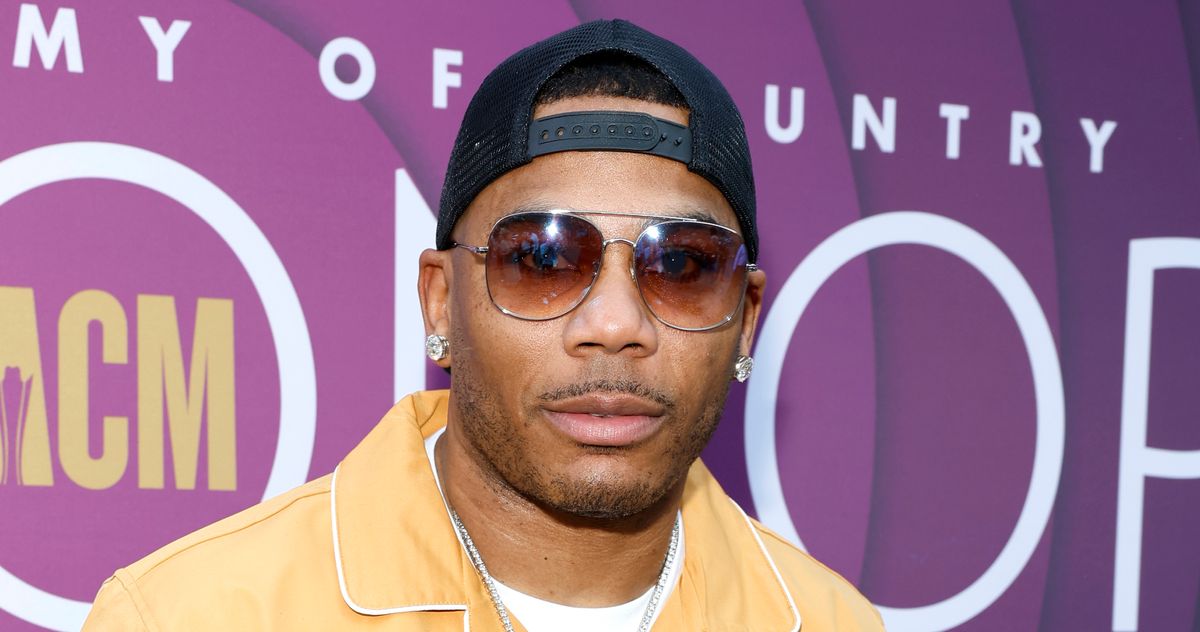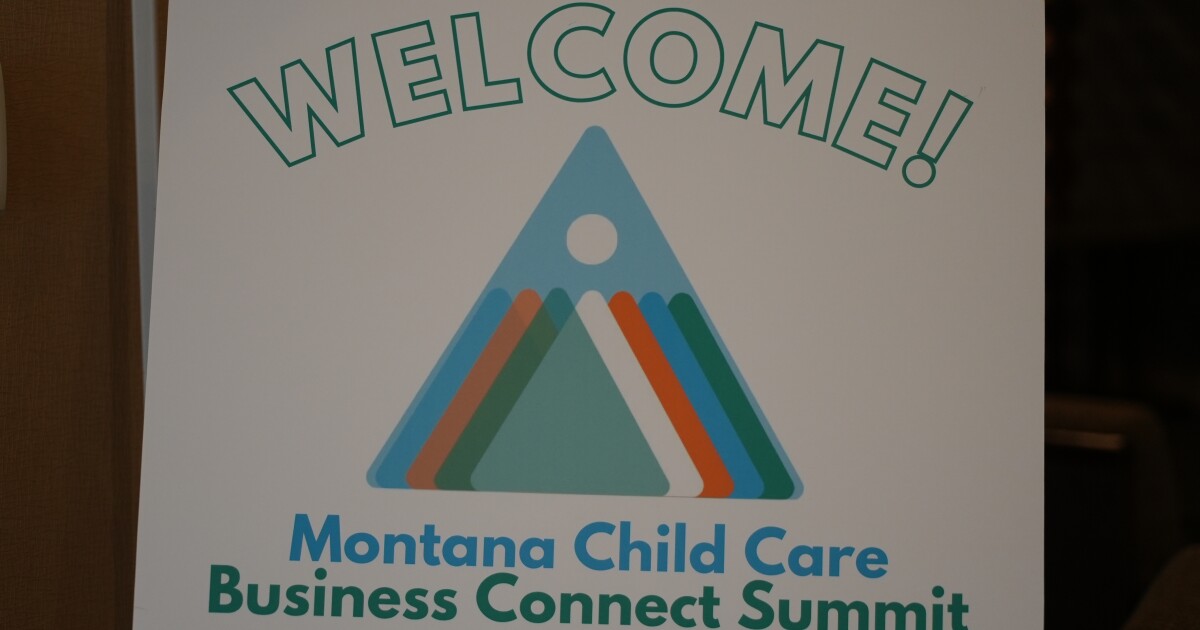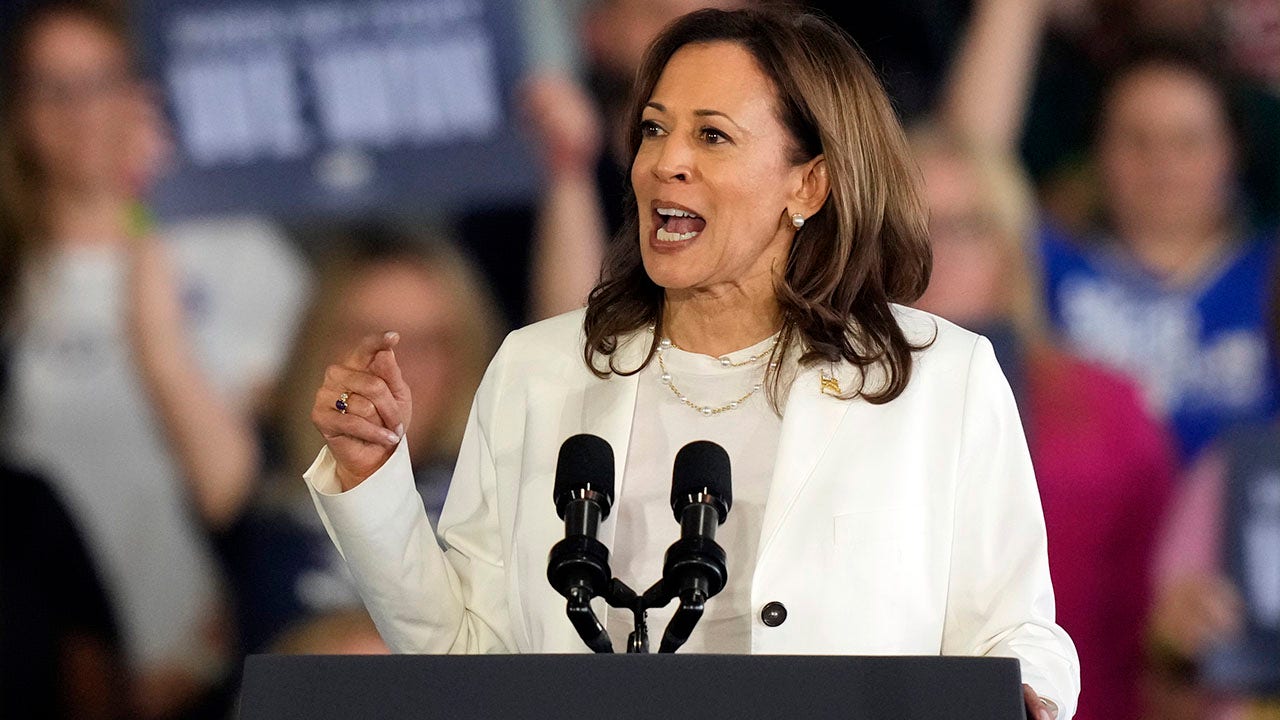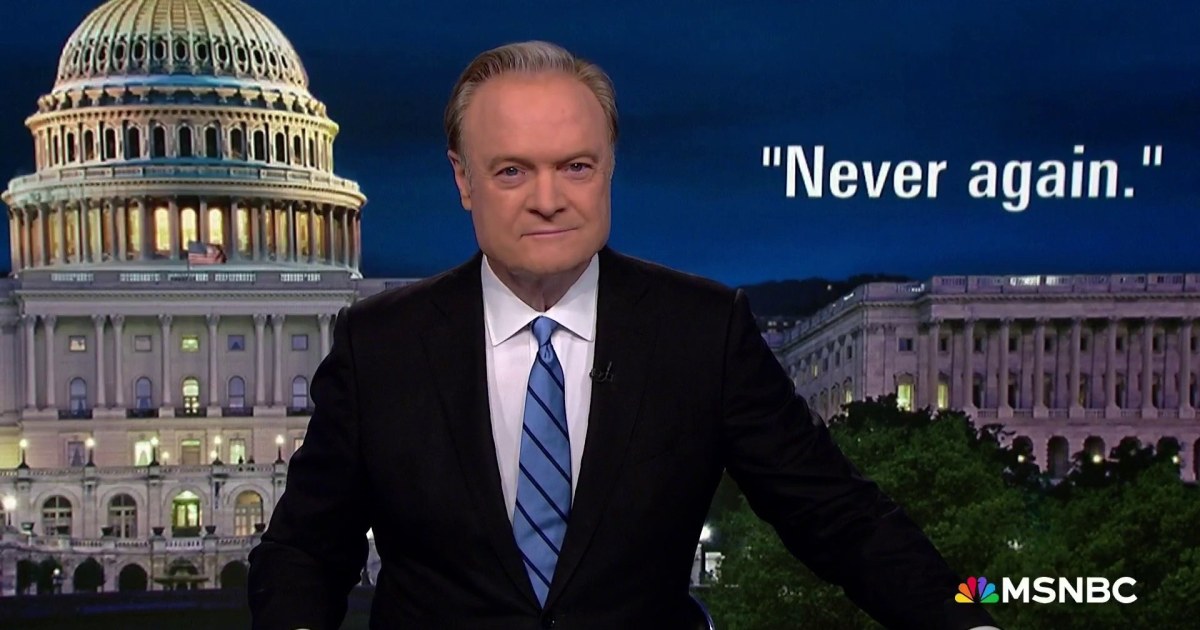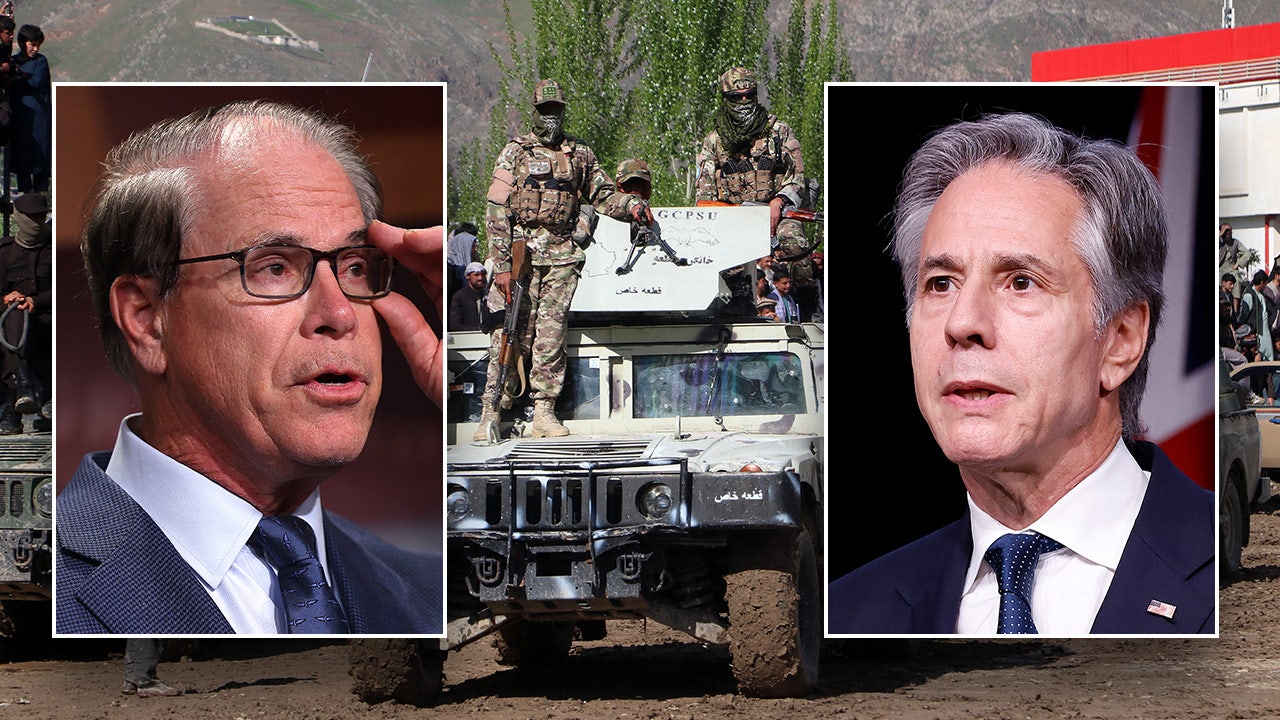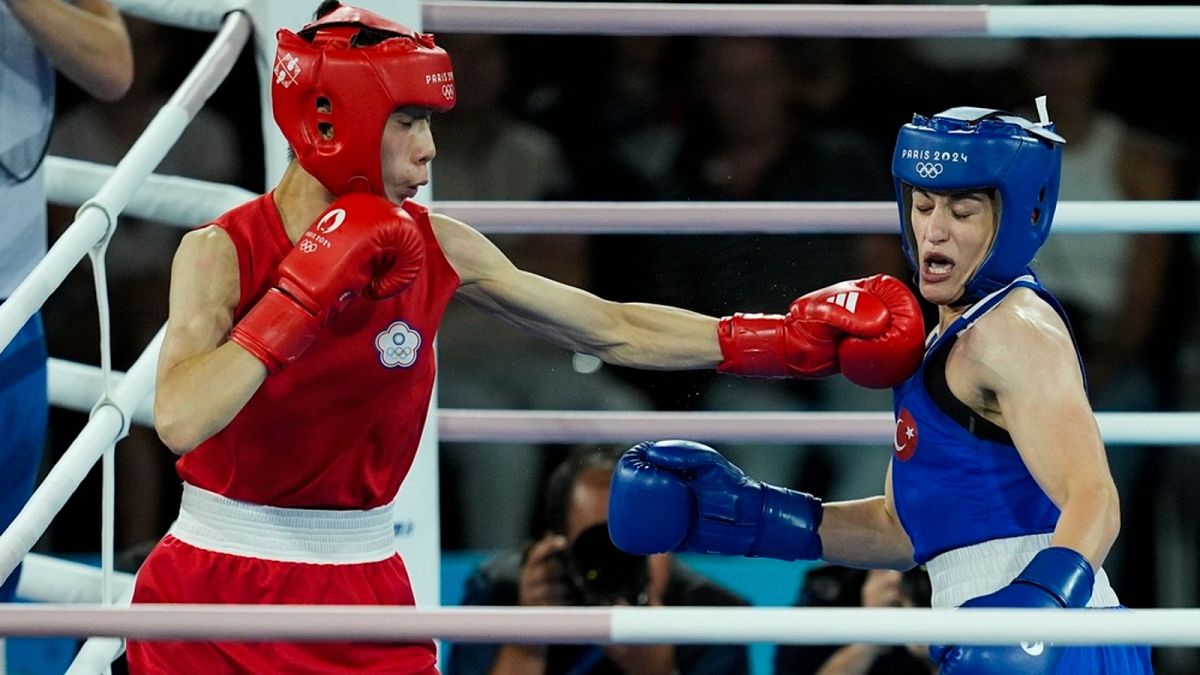Lifestyle
Can AI make better chocolate chip cookie recipes than humans? We taste tested 2

These chocolate chip cookies from America’s Test Kitchen are yummy. But can they top a cookie created by AI?
/America’s Test Kitchen
hide caption
toggle caption
/America’s Test Kitchen
Can artificial intelligence make a tastier chocolate chip cookie recipe than a human being?
At the risk of upsetting millions of grandmothers everywhere, we set out to find an answer.
We recruited Dan Souza, chief content officer for America’s Test Kitchen, for our experiment. He matched the Test Kitchen’s Perfect Chocolate Chip Cookie recipe against recipes from two AI programs, ChatGPT and DishGen.
Why chocolate chip cookies?
“Cookies, when you make small changes to ingredients, we find that you get some pretty massive differences,” Souza told Morning Edition’s A Martinez. So, it’s kind of a fun one to use as a litmus test for how successful a recipe development could be.”
How did the experiment work?
Souza asked each AI program to come up with a chocolate chip cookie recipe. The results were nearly identical. Souza said there’s a good reason for that.
“What it gave me was a pretty traditional chocolate chip cookie recipe. If you look on the back of Toll House [chocolate chip] morsels, which is where most chocolate chip cookie recipes kind of originate, it was a pretty good mimic to that. You have your classic ingredients, you have your flour, you’ve got white sugar and a little bit of brown sugar, a couple of eggs,” Souza said. “What you find with these engines is they’re pulling from all over the place and so you get sort of an average output, and it looked like a really average cookie to me.”
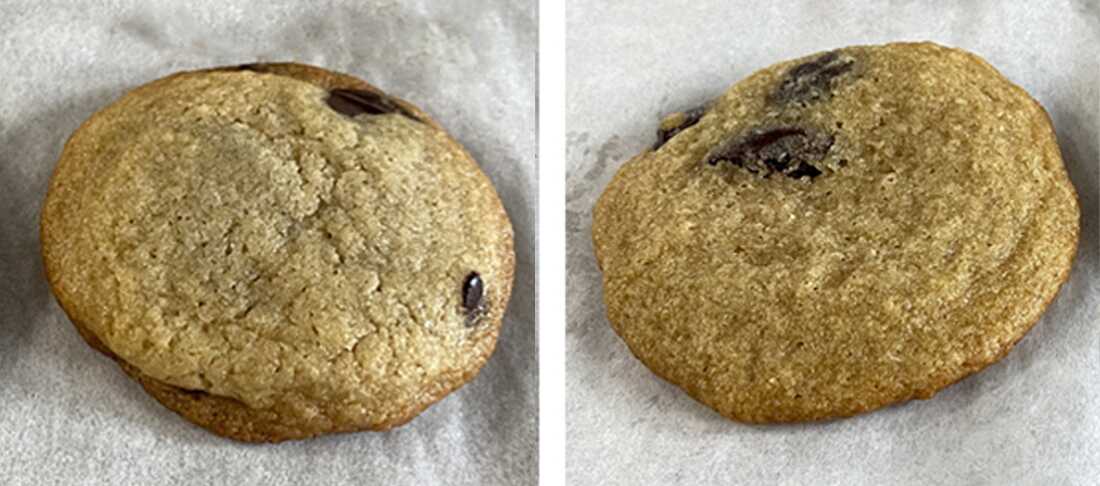
One of these cookies is different from the other. The one on the left was created from a recipe generated by ChatGPT. The cookie on the right came from a recipe app called DishGen.
/America’s Test Kitchen
hide caption
toggle caption
/America’s Test Kitchen
Souza said both of the programs were fairly straightforward. He typed in prompts of what he was looking for and the results popped up quickly.
DishGen had a “modify” button if, for example, you wanted to change the recipe to make the cookies chewier. But there were some frustrations, as well.
“The craziest thing is I would do the search — I did it multiple times on different days — and I actually got completely different recipes. So, the same prompt but I had a different recipe, which I found like totally infuriating. If I had something that I liked and I wanted to make it again, I couldn’t.”
The taste test
In our view, the cookies from ChatGPT and DishGen were pretty good but a little boring. A variation on the ChatGPT recipe that was intended to make the cookies more chewy actually made them too chewy.
The Test Kitchen’s Perfect Chocolate Chip Cookie recipe lived up to its name. The cookies were crunchy on the edges and chewy in the middle. They had a nutty flavor with a hint of toffee.
Souza said the Test Kitchen recipe has many innovations that the AI engines could not pick up on.
“It’s seemingly simple, but there’s a lot going on there,” Souza said. “One of the things we’ve done is we browned the butter, which does two things. It adds tons of rich, nutty flavor. But liquefying the butter also means that you get a denser cookie, which eats chewier. So, it’s really, really valuable.”
Souza said the AI recipes have a lot of potential, but that the technology is not quite there yet.
“It’s missing the people part of it. So, if you’re tasting a chocolate chip cookie recipe that your mom has made forever, there’s a big emotional pull there. And that actually influences how you taste something. You know, we eat with our eyes, but we also eat with all of our emotions and kind of everything that we bring into the picture. You’re never going to get that from an AI.”
Reena Advani edited the radio version of this story. Obed Manuel edited the digital.

Lifestyle
What it's like to travel to Maui right now — one year after the catastrophic wildfires

Five hundred feet outside the Lahaina burn zone, the tourists receive their leis.
As the torches of the Old Lahaina Luau flicker, bartenders mix mai tais and hula dancers get ready. After dinner, dancer and emcee Niki Rickard gathers the performers in a circle and asks the audience for “a moment of silence … to acknowledge all we have lost.”
A year after the deadliest U.S. wildfire in a century, which killed at least 102 people and leveled 2,200 structures, this is what passes for business as usual in West Maui. Though 98% of the island carries no visible signs of the fire, most of the city of Lahaina was leveled and remains behind roadblocks as crews begin the transition from cleanup to reconstruction.
Most of Lahaina burned and at least 102 people died in the wildfire that erupted on Maui last August. An image from the aftermath on Aug. 16, 2023.
(Robert Gauthier / Los Angeles Times)
In the first two weeks after the fire, most of the city’s 12,700 residents moved into hotels, with FEMA footing many bills. Since then, amid ferocious debate about the island housing shortage and how to rebuild, most fire survivors have moved to longer-term housing or left the island. Many are back at work now, tending to tourists.
This tangle of mourning, recovery and tourism has many travelers wondering if it’s possible or respectful to spend a vacation on Maui now.
The answer is yes, according to every resident, worker and visitor I asked in three days on the island. But tourism lags about 25% behind pre-fire levels, and the situation can seem as layered as a Maui onion. While the average hotel room rents for more than $500 per night, residents scramble for housing and equilibrium.
It’s easy to spend a week on the island in full vacation mode without setting foot in Lahaina. Conversely, the island’s recovery campaign includes a variety of “voluntourism” options (detailed below) for those who want to dedicate half a day or more to pitching in.
But some curious visitors fall between those extremes. Tourism workers say this can lead to hard feelings, especially when visitors try to photograph damage or ask intrusively about lost homes and loved ones. That’s when many Mauians turn away, get angry or post signs at the end of their block reading, “Locals still grieving. Show Respect. No tourists.”
“Be sensitive,” said Siobhan Wilson, co-owner of the Maui Butterfly Farm in Olowalu. “Don’t go up and ask people, ‘What did you see and what happened?’ If people want to talk, they will.”
“Come with aloha. Leave with aloha,” said longtime resident George Pali, sitting at a Wahikuli Wayside Park picnic table near some long-term tents. “You guys [in California] have wildfires all the time, right? So you have some idea.”
Here’s an update for anyone considering travel to Maui, including reasons why you might or might not want to include a stop in Lahaina.
What’s open in Lahaina, and what’s gone
Most of Front Street, Lahaina’s commercial backbone, is no more. Little remains to remind a visitor that this was the capital of the Hawaiian Kingdom in the early 19th century under King Kamehameha II. But the flames didn’t claim everything.
At the north end of the street, a handful of restaurants and a dive shop were left largely intact, including the Old Lahaina Luau, despite its thatched roofs. It reopened in March and attracts up to 350 guests nightly, many of them happy to be adding dollars to the diminished local economy.
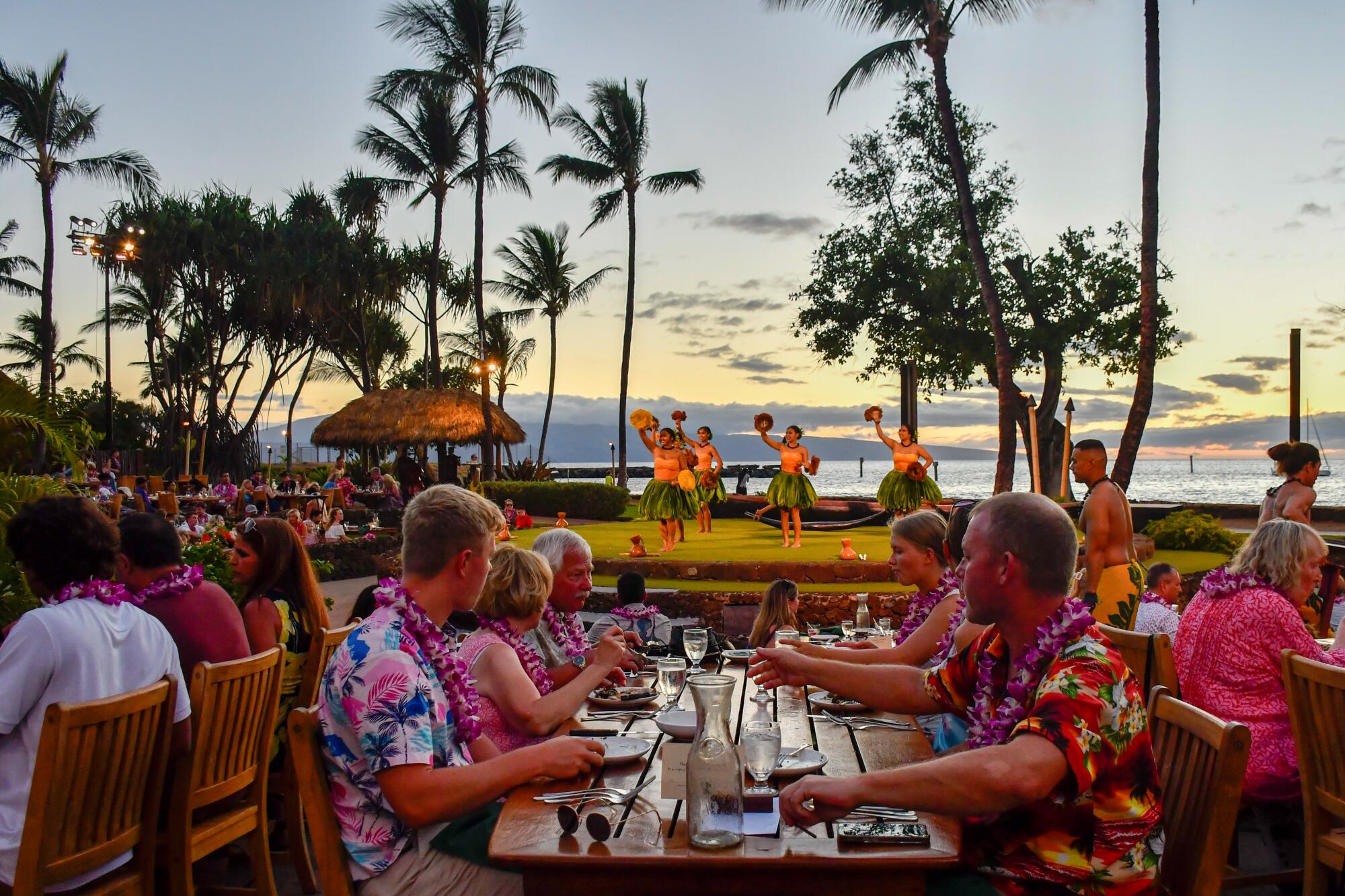
The Old Lahaina Luau reopened in March. The luau features dinner and an hourlong performance, including hula dancers, on the waterfront in West Maui.
(Christopher Reynolds / Los Angeles Times)
When Niki Rickard takes the microphone before those luau audiences, she doesn’t mention her own story. But it’s a potent one, and it hints at the experiences of many survivors.
Both of her parents are longtime employees of the luau, which started in 1986. Beginning about age 4, Rickard dreamed of dancing there, then landed a job doing just that. Now 30, she also handles sales and emcee duties, summarizing the island’s history of migration, colonization, whaling, plantations and resilience in diplomatically measured tones.
Last August, she had just returned from maternity leave when the fire broke out.
Neither Rickard, her husband or their daughter was injured, but their home burned.
“My daughter was 3 months old,” Rickard said in an interview.
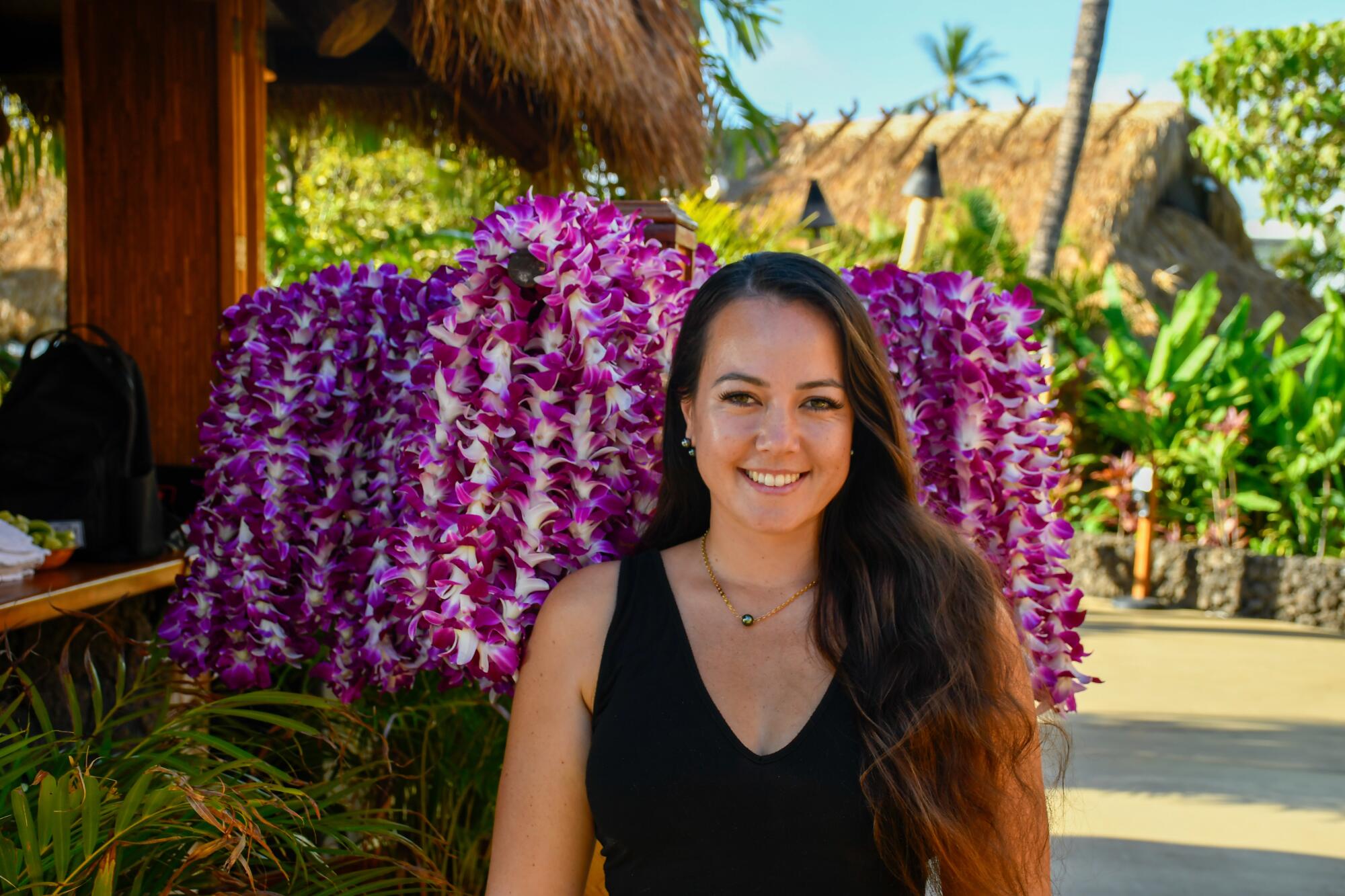
Niki Rickard, a dancer, emcee and sales agent for the Old Lahaina Luau.
(Christopher Reynolds / Los Angeles Times)
Since the fire, Rickard has been among the thousands of residents dealing with temporary housing, an island-wide child-care shortage and plenty of government and insurance red tape.
“A lot of people in the community are not so happy with the government,” she said carefully.
The luau’s director of public and cultural relations, Kawika Freitas, also acknowledged “a lot of negative feelings” from those who believe the island reopened to tourism too soon. But people need work, Freitas said, and the luau employs about 160 people.
On the same block, the Mala Ocean Tavern reopened in February. Aloha Mixed Plate and Star Noodle (siblings of the luau under the same owner) reopened in March and Aug. 1, respectively. Honu Oceanside is to follow in late summer or fall.
Many more reopenings are expected in the coming weeks and months, giving visitors more reasons to stop and perhaps spend. Meanwhile, because of Maui’s layout, many others will be driving through on their way north.
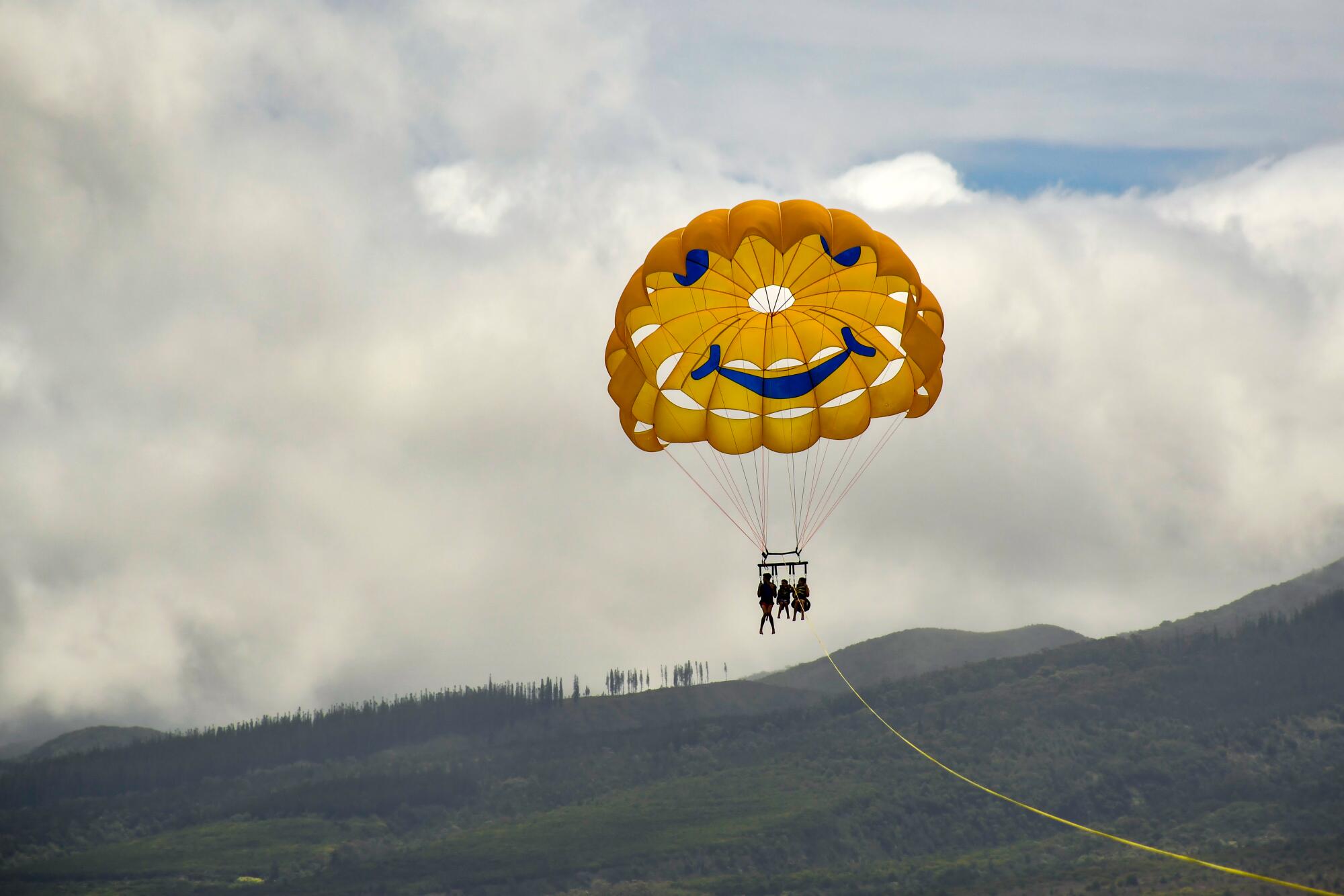
Parasailers soar off the Ka’anapali coast near Lahaina, the slopes of West Maui rising in the background.
(Christopher Reynolds / Los Angeles Times)
The drive along Lahaina Bypass highway
The August fire, which began near downed utility poles amid drought conditions and gusting winds, blackened 6,721 acres in Lahaina and the up-country area near Kula. It didn’t reach Maui’s east coast (which includes the famed road to Hana) or the southwest coast (which includes the city of Kihei and the Wailea resort area) or the northern coast (which includes Kahului airport).
Nor did flames get to the west coast hotels and condos that begin with Ka’anapali, just a mile north of Lahaina.
But to reach those resorts, visitors do drive the Lahaina Bypass highway. Just before the highway passes over Lahainaluna Road, those visitors see a sobering roadside shrine on their right — scores of crosses and photos, strewn with leis. (Having been warned that many residents see the memorial as a place for victims’ families and survivors only, I didn’t approach on foot.)
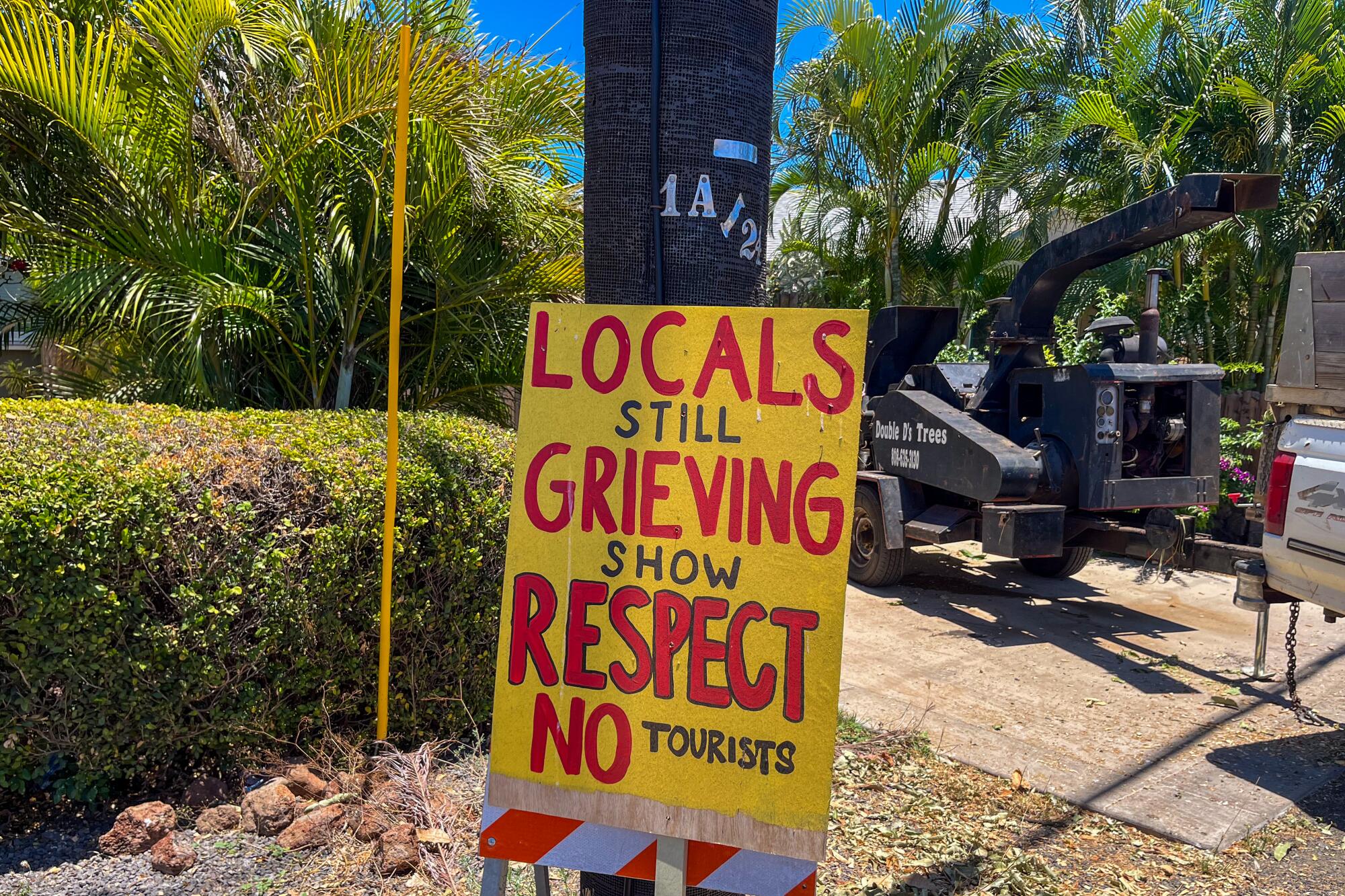
A cautionary sign hangs near a residential neighborhood in Lahaina, Maui, where cleanup and reconstruction continue.
(Christopher Reynolds / Los Angeles Times)

Roadside screens are decorated with artwork in Lahaina.
(Christopher Reynolds / Los Angeles Times)
In the next mile, as drivers transition from the highway to Keawe Street and Honapiilani Highway, several signs thank first responders, exhort the community to be strong and call for tourists to show respect. Only a few charred ruins are visible from the road. Six-foot-high roadside screens shield many properties from view.
Visitors won’t see Waiola Church, Lahaina Hongwanji Mission, the historic Baldwin Home or popular restaurants like Kimo’s, Fleetwood’s on Front Street or Cheeseburger in Paradise, all burned. The city’s iconic banyan tree, damaged but recuperating, remains off-limits.
FEMA reports that by July 31, cleanup crews had cleared 319,000 tons of fire debris, nearly 34 tons of asbestos and 3,000 fire-damaged cars, with 47 rebuilding permits issued by Maui County.
On Saturday, utility company Hawaiian Electric, the state of Hawaii and five other defendants announced a $4-billion settlement agreement with fire victims, pending court approval. Total damages have been estimated at $5.5 billion or more.
One Maui resident, asking to be unnamed, told me he’d just finished a six-month job in the burn zone, wearing a Tyvek suit and respirator, waiting for blessings before stepping onto home sites, scraping ash and asbestos, finding class rings, guns, jewels and puddles of melted aluminum.
Yet just north of Lahaina, a visitor reenters the Maui seen on postcards and screensavers.
What West Maui’s resorts look like and what they cost
In the morning, catamarans glide up to the beach, kids line up for surf lessons, and golfers head to the courses at Kapalua. At day’s end, legions gather to watch the sunset as daredevils leap from the Black Rock Beach boulders to the sea.
Though the Royal Lahaina and Outrigger resorts in Ka’anapali housed many fire survivors as recently as early July, state and federal officials say the vast majority have moved on to intermediate or permanent housing.
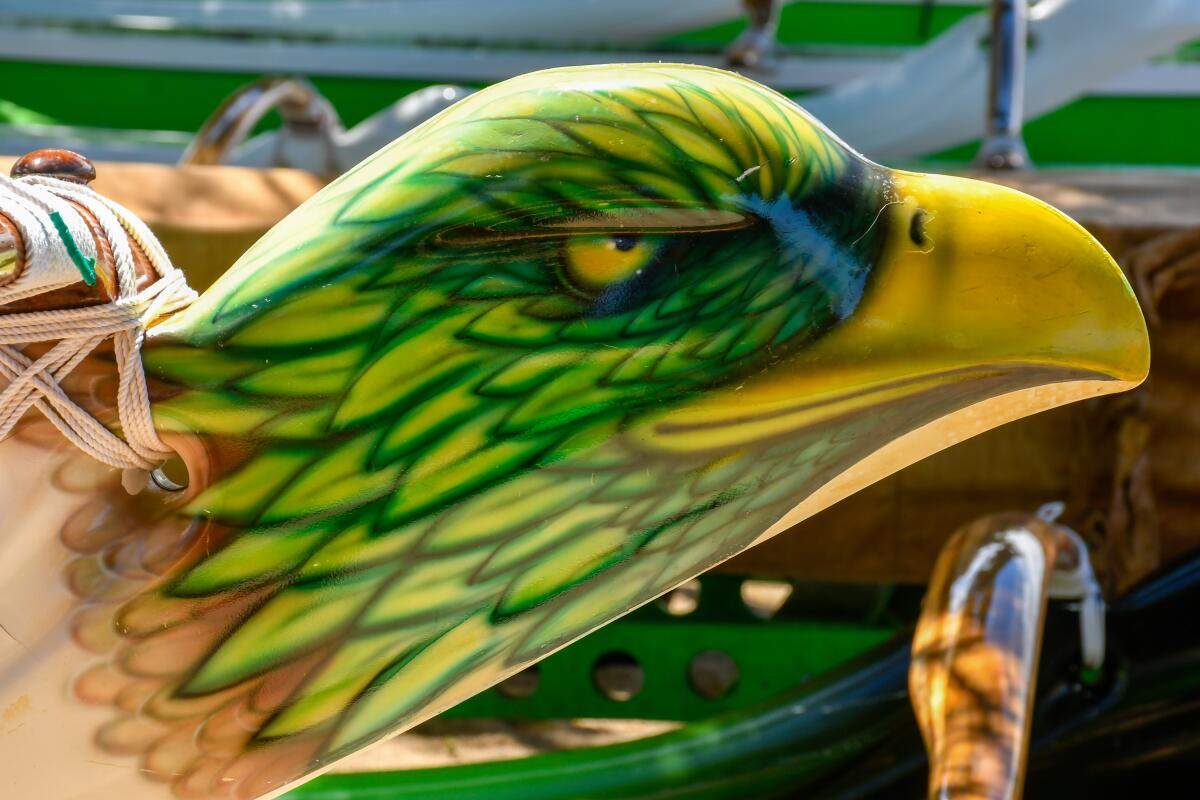
A custom paint job on an outrigger canoe on the Ka’anapali coast. (Christopher Reynolds / Los Angeles Times)

A surfing class in Ka’anapali. (Christopher Reynolds / Los Angeles Times)
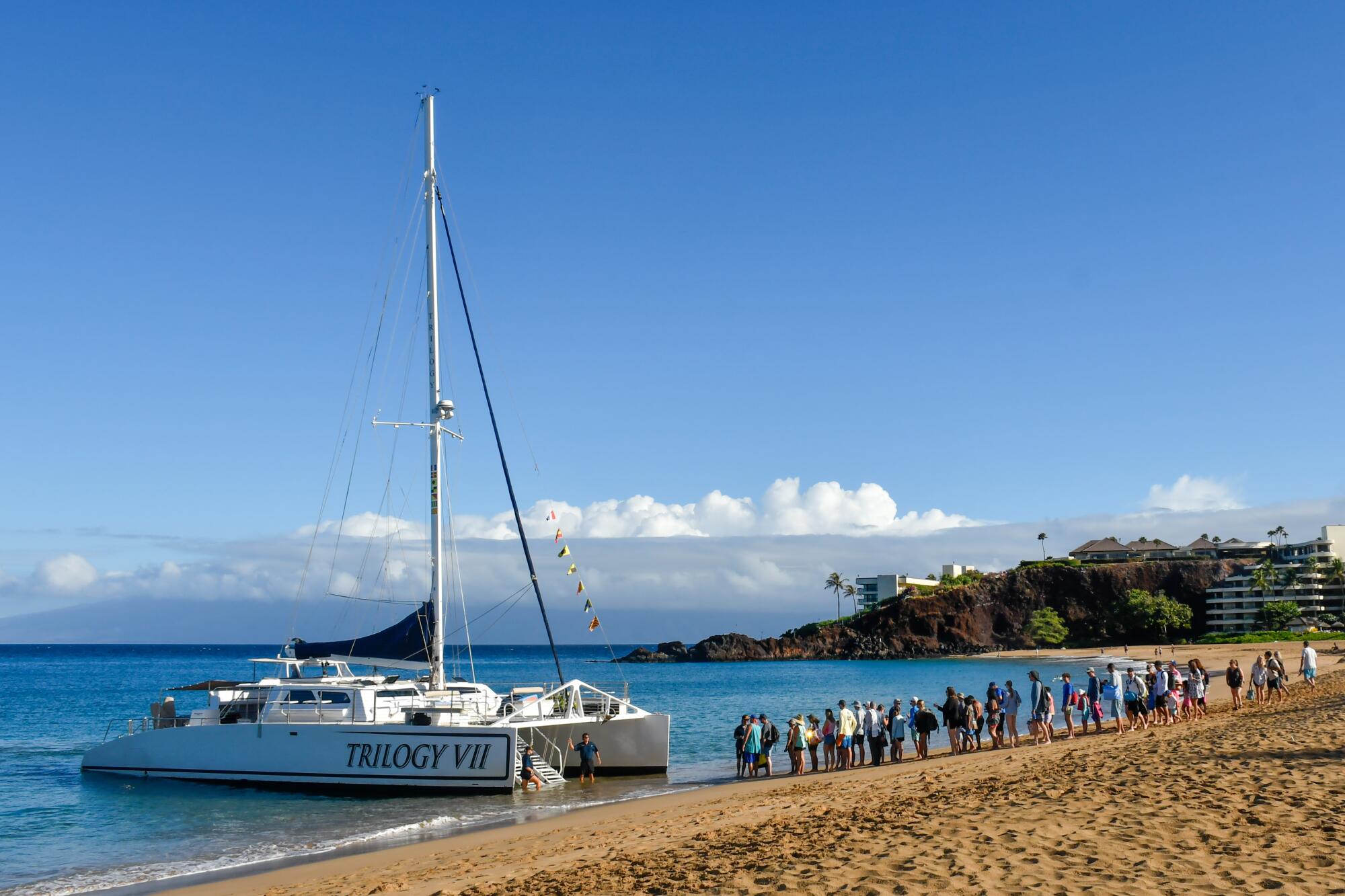
A catamaran waits near Black Rock Beach, Ka’anapali, West Maui.
(Christopher Reynolds / Los Angeles Times)
In June, Hawaii’s state tourism statistics show, visitor arrivals to Maui were down 21.8% from the year before, with spending down 27.1%.
The average Maui County hotel rate that month: $554 per night, down 10.5% from the year before, with a third of rooms empty.
The average vacation rental cost less — $401 per night, with a 44% vacancy rate. But that may soon change. Maui Mayor Richard Bissen has proposed converting 7,000 condo units from short-term use to long-term within three years, creating more housing for residents.
“We’ve been coming here for years, and I have never seen the [Ka’anapali] walkway so clear,” said Russ Hill of Santa Clarita, who has a West Maui timeshare.
A moment later, he strapped into a parasailing rig, zoomed 500 feet above Ka’anapali Beach and saw exactly what he wanted to see: island slopes under clear blue skies, a line of hotels along the beach, a few leaping dolphins and no reminders of the fire except the boat captain’s “Maui Strong” T-shirt.
How visitors become volunteers
Napili Noho, an emergency service hub in Napili Park, stands about three miles north of Ka’anapali. It didn’t exist before the fire. Now it often gets 200 guests in a day.
They browse a free store stocked with food, shoes and hygiene items, sit for meals (prepared with help from other charities) or step into the lomi lomi tent, where masseurs and chiropractors give free treatments.
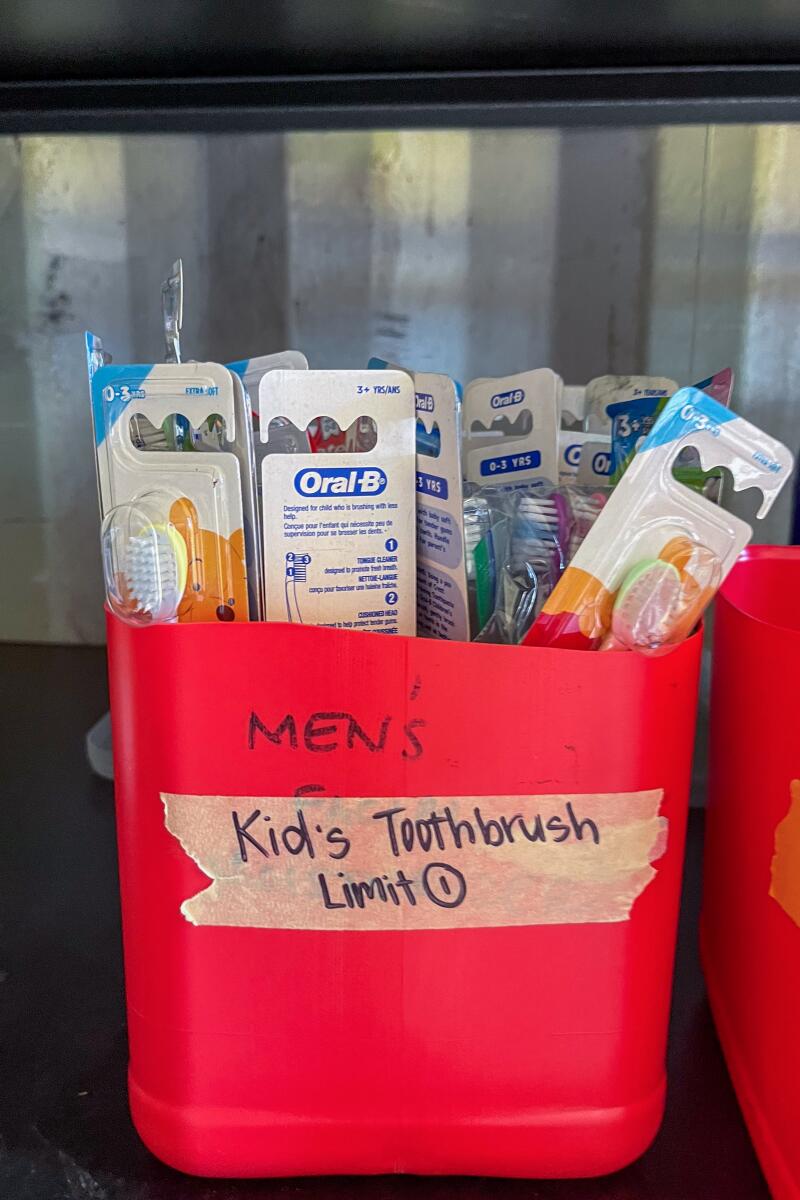
The Napili Noho emergency resource hub, created after last year’s fire, offers food and household items for those in need. (Christopher Reynolds / Los Angeles Times)
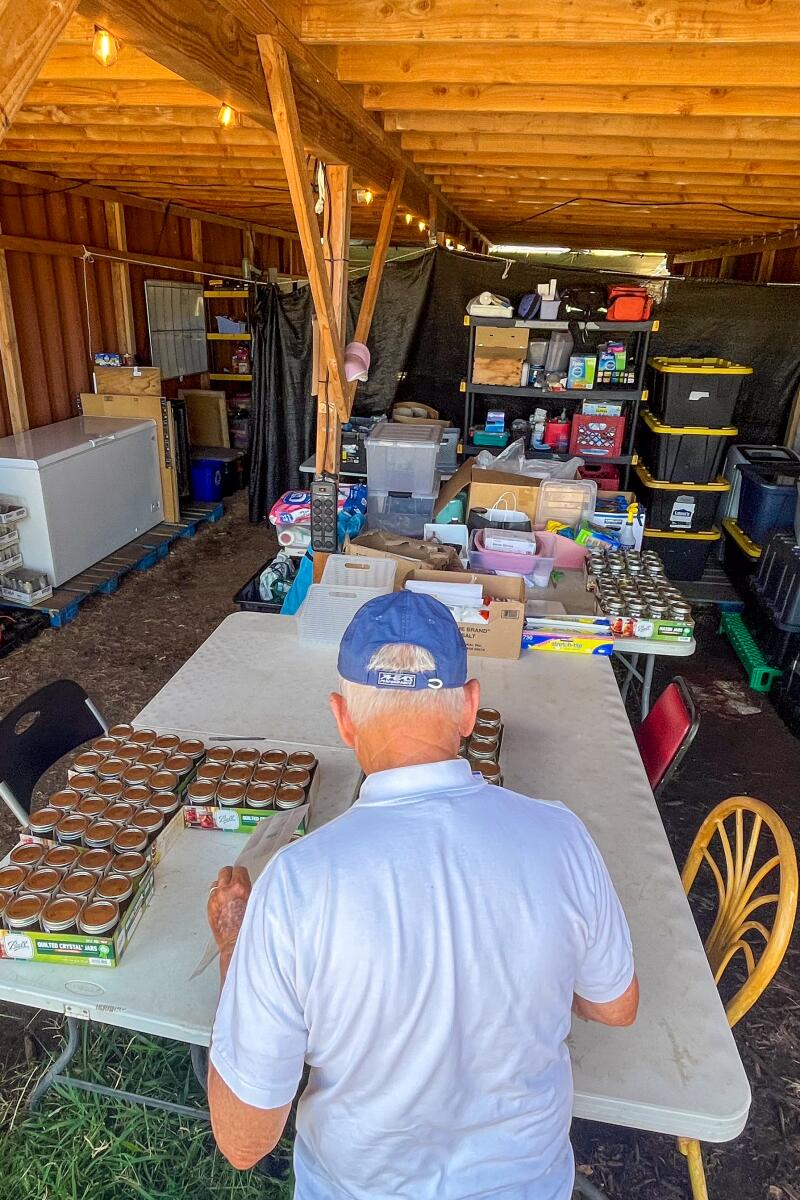
Volunteer Tom Fox, visiting from California, works at Napili Noho. (Christopher Reynolds / Los Angeles Times)
Most days, at least one short-term volunteer visitor shows up, having signed up online. On the Tuesday I arrived it was Tom Fox, 81, a semiretired real estate agent from Pleasanton.
For years, Fox and his wife have been visiting West Maui to play golf and lie low. They were at their Napili condo when the fire struck and wound up inviting their housekeepers to stay in the condo for several weeks.
Now the housekeepers have moved on, Fox said, and he’s found that he’s not as good as his wife is at keeping busy.
“So I found out about this place and came on down,” Fox said. The day before, he’d bought Mason jars for storing cooking oil. Now he was labeling them for community members who might speak English, Hawaiian, Spanish, Chinese, Tagalog, Tongan or Samoan.
Around him, other workers were breaking down bulk packages of salt, soap and other goods, including another volunteer from off-island, a 38-year-old man who goes by the name Savage.
“I was supposed to be here five days,” he told me.
Until last August, Savage said, he was working as a health-focused life coach in Las Vegas. After the Maui disaster, he joined an island-bound group of volunteers from his church.
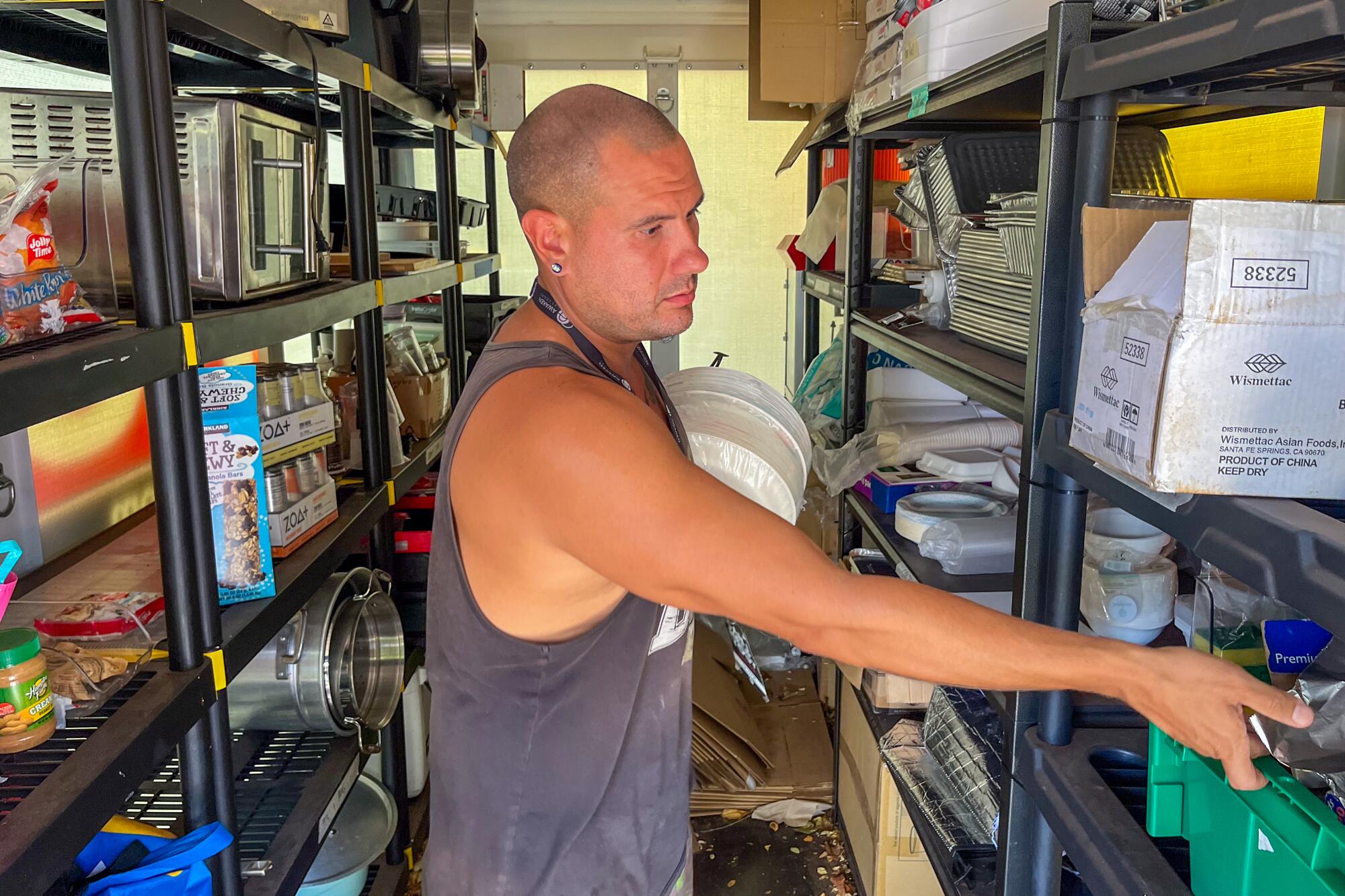
A volunteer who goes by the name Savage tends to supplies at the Napili Noho hub.
(Christopher Reynolds / Los Angeles Times)
Once he arrived, Savage, who said he has Dakota Sioux heritage and is an Air Force combat veteran, found that “this was very familiar to me.”
Eleven months after arriving, Savage moves from task to task in his flip-flops, walkie-talkie in hand, four days a week, helping displaced residents feed families and cope with makeshift living situations. He’ll be here “until I’m at peace that it’s time to move on.”
The key, Savage said, is offering comfort without giving advice or trying to counsel anyone. That might mean “asking aunties for cooking recipes,” he said. “Just talking story. Our community may not need to shop as much as they need distractions from life. They might not know where they’re going to be next week.”
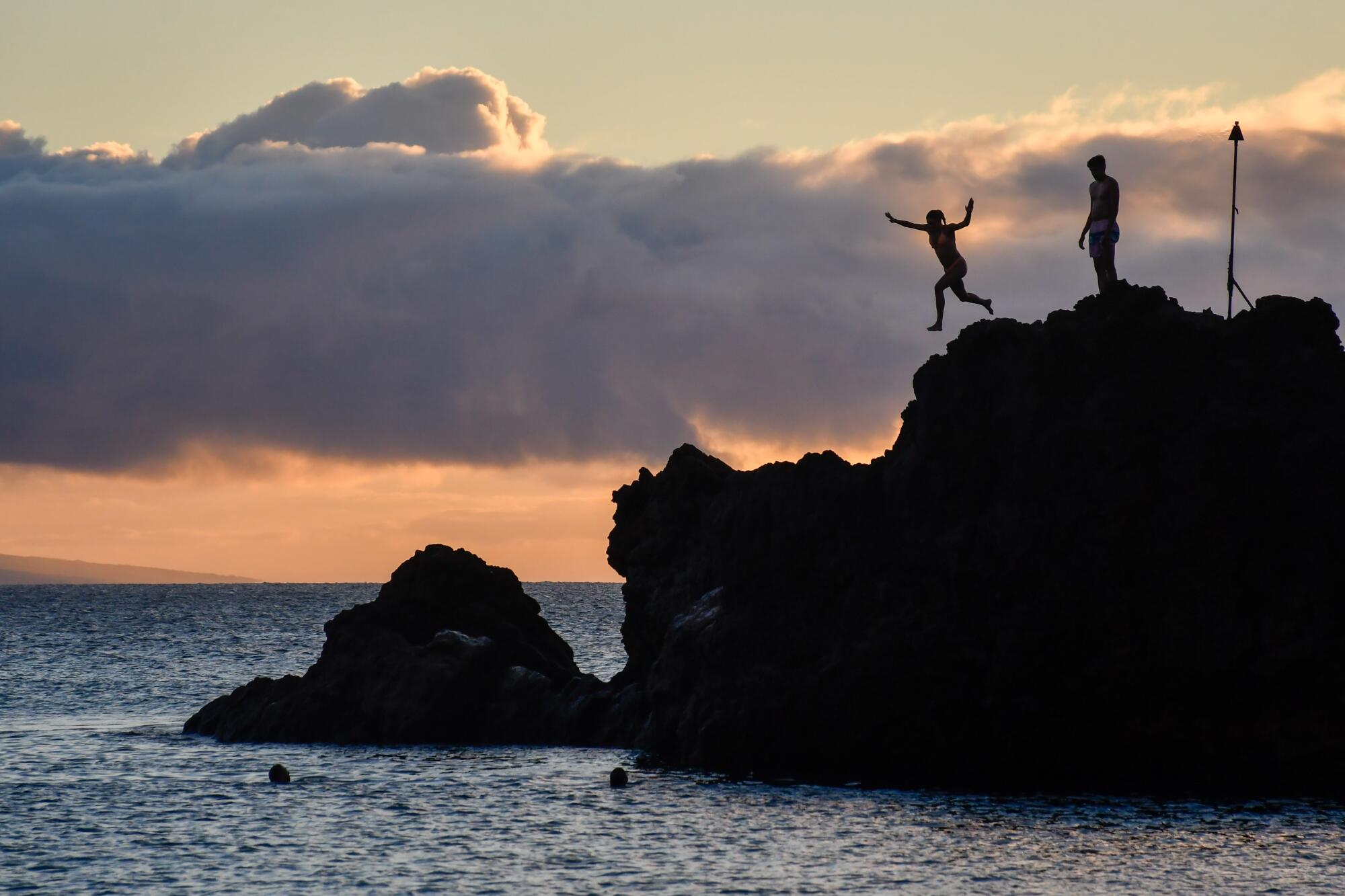
Black Rock Beach, Ka’anapali, West Maui.
(Christopher Reynolds / Los Angeles Times)
If you go
What to eat
Old Lahaina Luau, 1251 Front St., Lahaina; (808) 667-1998. Lavish dinner al fresco with open bar, followed by an hourlong show with hula, drumming and chanting. Adult admission: $230.37, including gratuity.
Aloha Mixed Plate, 1251 Front St., Lahaina; (808) 661-3322. Patio restaurant (moved down the street since the fire) offering breakfast, lunch and dinner. The Chow Funn noodle bowl (ground pork, bean sprouts, green onions; $15) makes a tasty lunch.
Mala Ocean Tavern,1307 Front St., Lahaina; (808) 667-9394. Brunch and dinner. Perhaps the most elegant restaurant you’ll find with a tin roof and walls. Website includes a link for donations to staff. The signature cocktail is a Makai Tai ($18). Dinner main dishes $28-$61.
Ulu Kitchen, Westin Ka’anapali, 2365 Ka’anapali Pkwy., Lahaina; (808) 868-0081. Breakfast, lunch and dinner on the beach in Ka’anapali. Main dishes $28-$69.
Where to stay
Outrigger Kaanapali Beach Resort, 2525 Ka’anapali Pkwy., Lahaina; (808) 661-0111. A three-star hotel on a coastline of mostly four-star resorts, its location impeccable, with a whale-shaped pool. Rates start at about $370, plus a $35 daily resort fee.
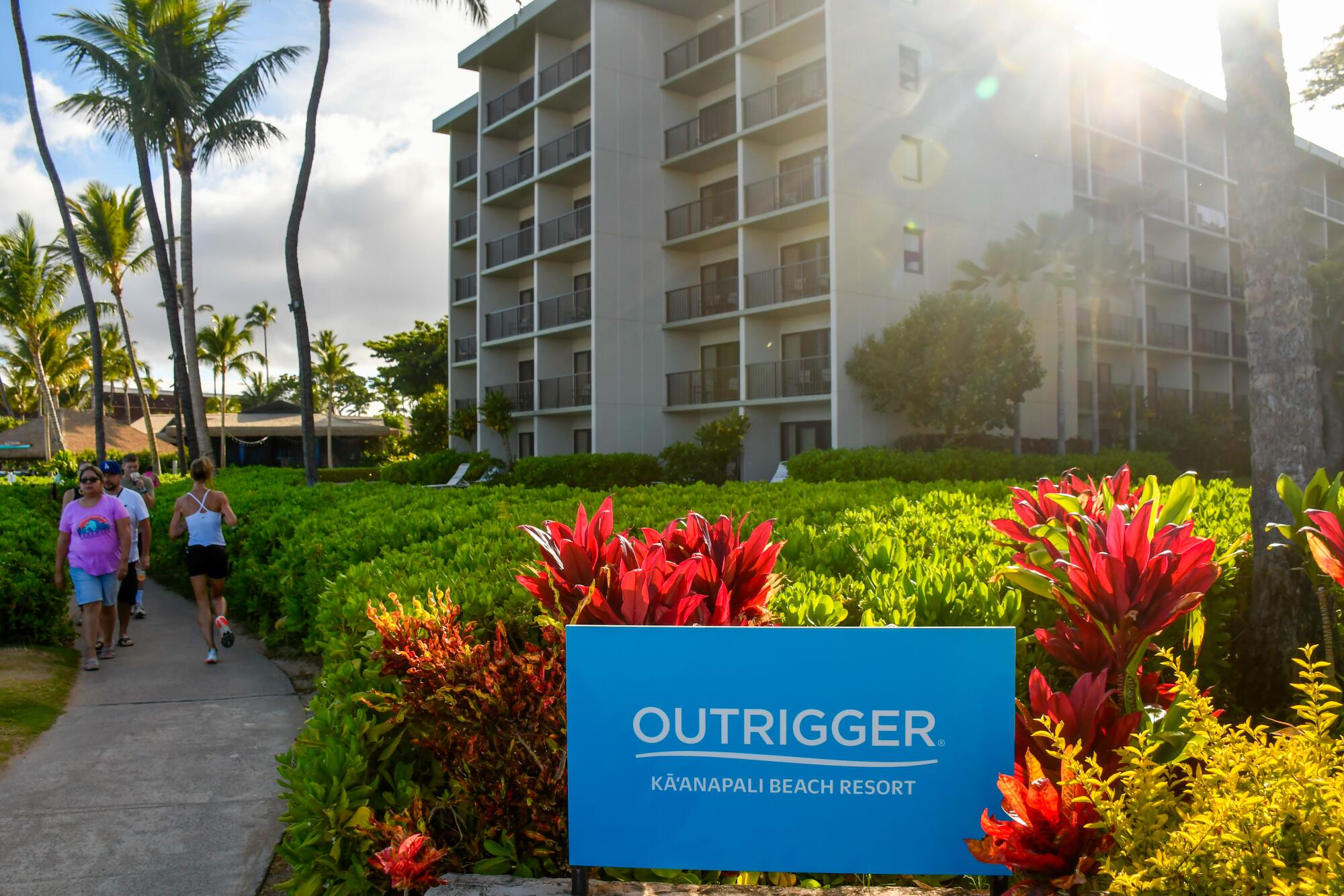
The Outrigger Ka’anapali Beach Resort, in West Maui, is one of many hotels that housed displaced residents after the Lahaina wildfire.
(Christopher Reynolds / Los Angeles Times)
Things to note
In the high country at the south end of Maui, Haleakala National Park’s popular Crater Road and summit area have been closed periodically because of nearby brushfires. Check the park website before planning a visit.
To volunteer on Maui, don’t rely on last-minute suggestions from your hotel’s concierge or activities desk. Make a plan in advance. Mauinuistrong.info includes many volunteering options, as does the website of the Hawaiian Tourism Authority. Malama Kula operates in the up-country area. Napili Noho runs the emergency services hub in Napili Park. Maui Cultural Lands runs programs to protect cultural resources, plant native vegetation and battle invasive species, with volunteer workdays every Saturday in the Honokowai Valley above Ka’anapali. Similar work happens Wednesdays and Thursdays at Kipuka Olowalu, south of Lahaina.
The Lahaina Cannery and Lahaina Gateway malls are open, and more Lahaina businesses are reopening every month. This website tracks reopenings.
Lifestyle
When poor Black communities were struggling with COVID, this surgeon stepped in

Dr. Ala Stanford’s new memoir is Take Care of Them Like My Own.
Simon & Schuster
hide caption
toggle caption
Simon & Schuster
As a pediatric surgeon, Dr. Ala Stanford operated on children, infants and sometimes fragile premature babies. But when the pandemic hit in 2020, she left her job to found the Black Doctors COVID-19 Consortium, setting up shop in parking lots, churches and mosques where she provided tests and vaccines to underserved Philadelphia communities like the one she grew up in.
“I believe you go to the most vulnerable,” Stanford says of her outreach. “I’ve saved more lives in a parking lot than I ever did in an operating room.”
Early in the pandemic, Stanford realized that bureaucratic red tape was preventing vulnerable community members from getting access to COVID testing. She responded by contacting LabCorp, and ordering that the tests be billed directly to her.
“I wanted [testing] to be barrier free,” Stanford says. “I just said, ‘If you have been exposed and you need a COVID test, come to us.’ That’s it.”

After vaccines became widely available and COVID-19 became less deadly, the consortium expanded its services by establishing clinics in Black communities around the city. Stanford writes about her experiences with COVID and in community health in the new memoir, Take Care of Them Like My Own: Faith, Fortitude, and a Surgeon’s Fight for Health Justice.
The title of her book borrows from a guiding principle of her medical practice: “With every child I operate on, with every adult that I cared for during COVID and beyond, … I just try to treat them like I would pray someone would treat my children and my husband,” she says.
Interview highlights

Take Care of Them Like My Own
Simon & Schuster
hide caption
toggle caption
Simon & Schuster
On setting up COVID-19 testing sites for underserved communities
All of the data where people were having higher incidence of disease, the demographics, it was all on phila.gov. … Once I had those zip codes, I put them in order of sickest to least sick. And then I said, “OK, it’s Black people in the city of Philadelphia that are three times more likely to contract the disease and die.” So where do they trust? And for me, in my experience, it’s mosques. It’s churches, it’s community centers. And so I asked my pastor to help me identify a church or a mosque in each zip code where … the disease was the highest and that’s where we targeted. We went to where the need was the greatest. And we set up shop right there.
On how the 2020 pandemic “shelter in place” protocols impacted poor communities
When you’re saying to everyone, “Shelter in place,” and “Don’t go out into the public,” but you can’t afford to shelter in place because you have to go out into the public to support your family, when you’re saying, “Buy a bunch of food for a month and keep it stored,” and people don’t have the money to do that — it’s sort of like the adage of telling a bootless man to pull himself up from his own bootstraps. It’s like the recommendations were applicable for certain socioeconomic tiers in society and not for others. And so, in my mind, I hope we never have another pandemic again or a public health crisis. But those who have the greatest need are where you put the emphasis. And it’s not to say that you can’t take care of everybody at the same time, but there should be more emphasis on where you will see the greatest death and disease.
On the narrative that Black people wouldn’t get the COVID vaccine because of distrust in the government
Being [a] physician scientist, I said, “Why don’t we ask them?” So it was October of 2020 and it was flu season. And so in addition to doing COVID tests, we were also doing flu shots. And … when they came in, we did a survey … and we asked them if a vaccine were available today, what would make you take it? What would you be concerned about? … What I learned more than anything is that the majority of people said that they did trust the government to produce a vaccine, and yes, they would take it.
On why she got the COVID vaccine on camera
So when the vaccine came about, people had already started to develop a level of trust with us. But even that wasn’t enough for everyone. And so we led by example and we, on camera, went to get vaccinated. A lot of folks from the Black Doctors Consortium live on camera, we were vaccinated. And because people were saying, “Doc, when you say it’s OK, I’ll get it. When you roll up your sleeve, I will get it.” …

We listened to what people’s fears were and … some of it was, “I’m scared of needles.” … Or someone said, well, “I’m allergic to eggs, so I think I might be allergic to the vaccine.” You had to ask rather than assume you knew 1.), that they didn’t want it, and 2.), the reason why. And so I let the people educate me so that I knew best how to care for them.

“You go to the most vulnerable,” Dr. Ala Stanford says her work in parking lots during the pandemic.
Simon & Schuster
hide caption
toggle caption
Simon & Schuster
On middle- and upper-class people trying to get vaccines that were specifically for underserved communities
When I started seeing Teslas and Range Rovers in the parking lot in North Philly, I was like, “What is going on here?” Because most people take public transportation anyway. And these were some very expensive cars in my parking lot. And I would say it doesn’t help if you come to this community and take a vaccine and go back to your place in the suburbs or wherever, where you’re sheltering in place in your own bubble, and you’re not interfacing with the public, and then the people who are interfacing with the public — they’re going to work and they’re more exposed and they’re more likely to contract the disease — don’t have it. It doesn’t make the pandemic end any sooner if you do that. It’s not going to allow you to go on vacation any sooner if you take from those who are the ones who are most at risk. …
And what we started to do was oversample from the zip codes where the positivity rate was the highest, and people told me I was discriminating. Who was I? I didn’t have the right to do that. And I said, “This is a public health crisis and in a public health crisis you go to those who have the greatest disease, the greatest morbidity, mortality, and death, that’s where we went, right?” And later the city did the same thing. But for me, I got lots of sort of hate texts and direct messages and all those sorts of things, but I knew it was the right thing to do, so I just pressed on.
On the American Medical Association classifying racism as a public health issue in 2020
You have to acknowledge that bias exists in health care. So it’s great that the American Medical Association says it exists. But do you believe it? As someone in health care, do you believe that you play a role because of your own lived experience and bias that you bring into the exam room and into the operating room? And I think until the caregivers and educators acknowledge that we all have that bias, that we believe that we do, that we identify ways that we can change it and that we act on those things we identify, and then we share it with others. … Until we do that, that’s when you see real change.
Sam Briger and Thea Chaloner produced and edited this interview for broadcast. Bridget Bentz, Molly Seavy-Nesper and Meghan Sullivan adapted it for the web.
Lifestyle
Japan's benchmark Nikkei 225 index soars more than 10% after plunging a day earlier
TOKYO (AP) — Japan’s benchmark Nikkei 225 share index soared as much as 10.7% early Tuesday, a day after it plunged the most in 37 years.
The index gave up some of those gains as it wavered throughout the day but closed 10.2% higher at 34,675.46. Other Asian markets also were higher after sharp losses on Wall Street that were dramatic but not on the same scale as Monday’s 12.4% nosedive in Tokyo.
Many shares rose by double-digit percentages similar to their losses a day before, with automaker Toyota Motor Corp. rocketed 12.8%.
Computer chip maker Tokyo Electron jumped 16.6%, Honda Motor Co. advanced 14.7% and Mitsubishi UFJ Financial Group was up 5.8%.
The losses of the past several sessions followed a move by the Bank of Japan last week to raise its main interest rate from nearly zero. Such a move helps boost the value of the Japanese yen, but it also led traders to scramble out of deals where they had borrowed money for virtually no cost in Japan and invested it elsewhere around the world.
Officials from Japan’s Finance Ministry, Financial Service Agency and the Bank of Japan met Tuesday to address the recent market gyrations.
Atsushi Mimura, a top ministry bureaucrat, declined to comment directly on the specifics of the market, as is government policy. But he noted that market experts were saying recent volatility reflects various global developments, and markets are going up and down elsewhere as well.
He cited geopolitical risks like rising tensions in the Middle East and recent economic data. He also pointed to increases in wages and investment in Japan.
“We maintain the view that the Japanese economy is gradually recovering, going forward,” he told reporters.
The government officials and the central bank reconfirmed their agreement to watch internal and external fiscal situation, and work together “as one,” said Mimura, vice finance minister for international affairs.
When asked, Mimura declined to comment on whether the recent BOJ rate hike had triggered the market’s movements. He said the government was closely watching the foreign exchange rates and aiming for stability as always.
Various factors combined to cause Monday’s carnage, according to Stephen Innes of SPI Asset Management, likening Tuesday’s bounce to a “lifeboat.”
“As always with the market, take this to heart: Yesterday’s misery often turns into today’s punchline. The swift twists and turns of trading can transform what seemed like a dire situation into a fleeting memory, one that’s often laughed about in trading rooms the next day,” he said.
The Nikkei is now up 7.7% from a year ago, but more than 9% below its level three months ago. Its biggest ever percentage gain was 14.2% in October 2008.
-

 Mississippi1 week ago
Mississippi1 week agoMSU, Mississippi Academy of Sciences host summer symposium, USDA’s Tucker honored with Presidential Award
-

 Culture1 week ago
Culture1 week agoHe raped a 12-year-old a decade ago. Now, he’s at the Olympics
-

 News1 week ago
News1 week agoU.S. men's gymnastics team breaks 16-year Olympic drought with a team bronze
-
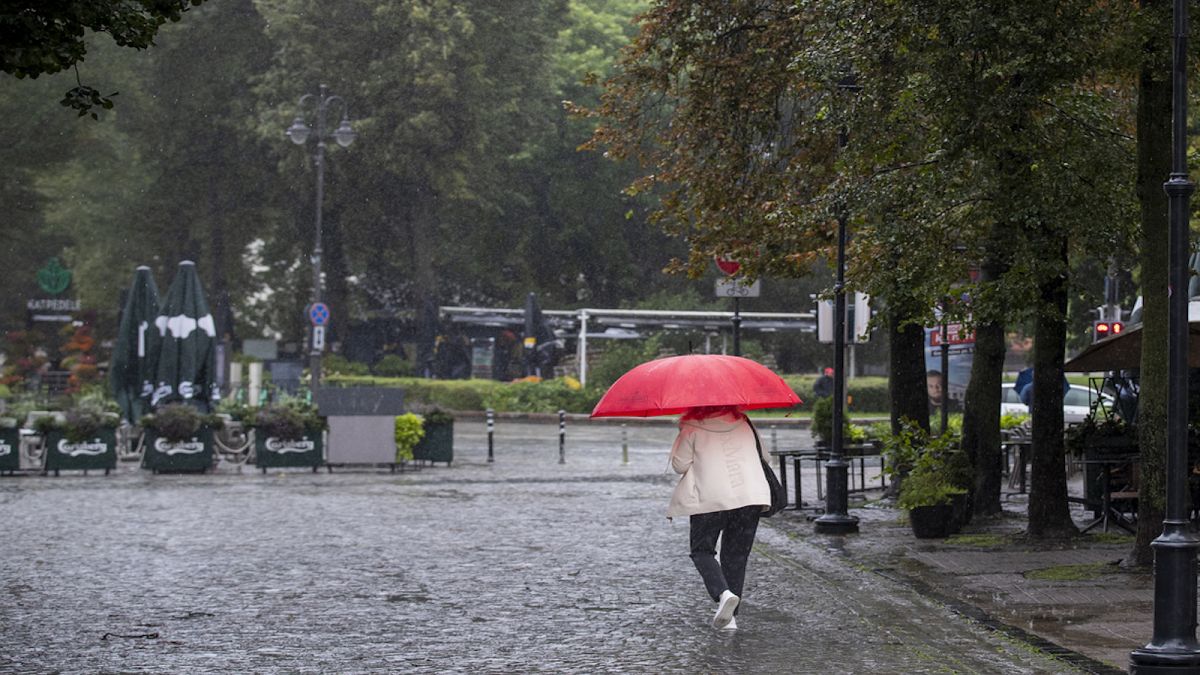
 World1 week ago
World1 week agoOne person dead as heavy storms hit Baltic states
-

 World1 week ago
World1 week agoThe Take: The aftermath of Venezuela’s contested election results
-
Business1 week ago
End of an era: Southwest Airlines will end open seating, introduce red-eye flights
-
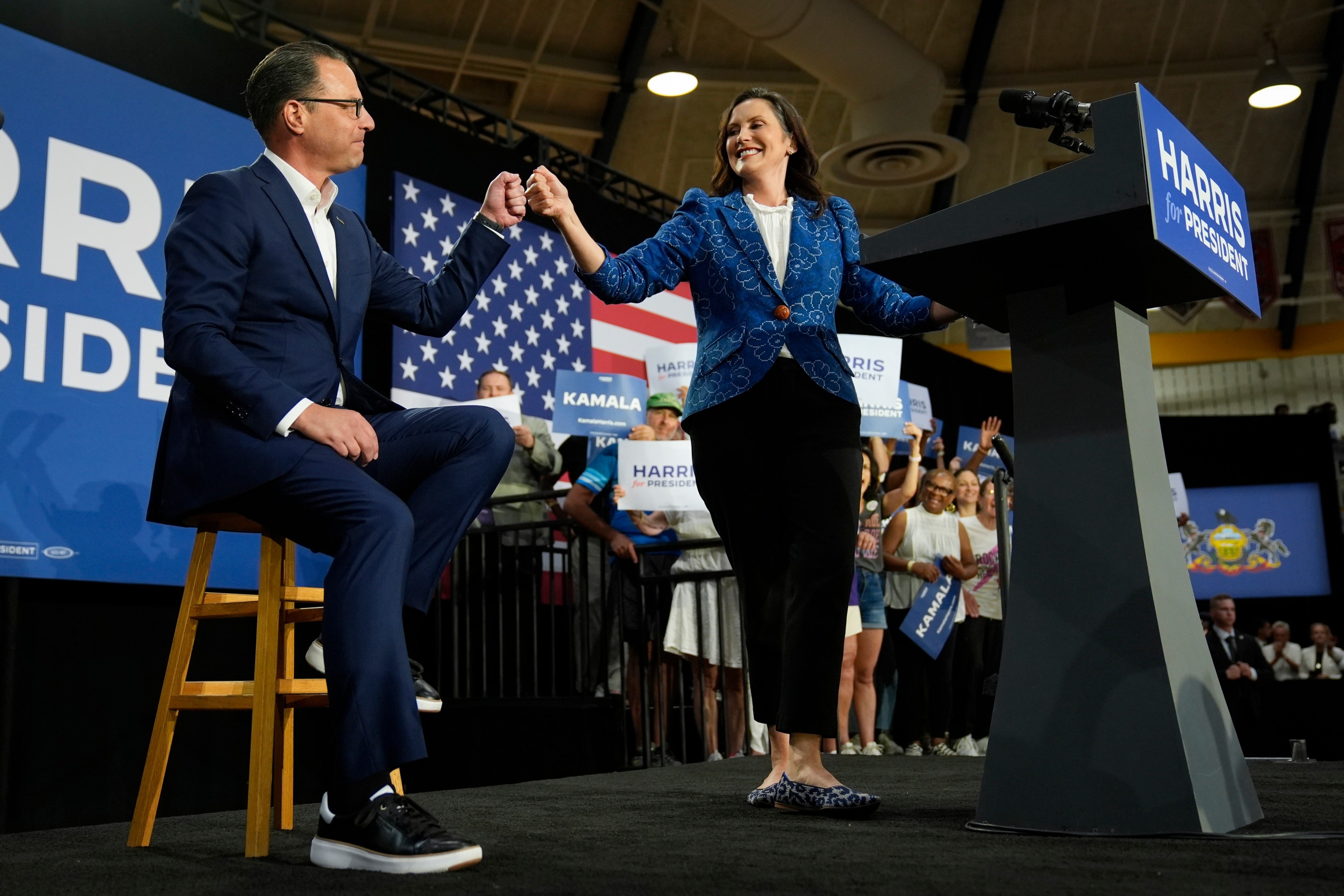
 News1 week ago
News1 week agoGovs. Shapiro, Whitmer stump for Harris in Montgomery County
-

 World1 week ago
World1 week agoMeloni meets Xi as Italian PM seeks to ‘relaunch’ ties with Beijing




